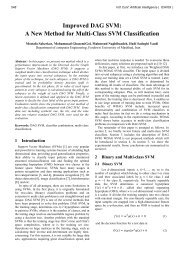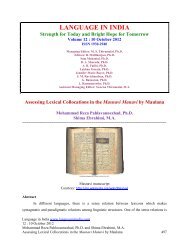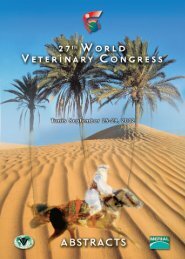and Bone Area in Professional Water Polo Players and Non-Athletes
and Bone Area in Professional Water Polo Players and Non-Athletes
and Bone Area in Professional Water Polo Players and Non-Athletes
Create successful ePaper yourself
Turn your PDF publications into a flip-book with our unique Google optimized e-Paper software.
Intl. j. Basic. Sci. Appl. Res. Vol., 2 (6), 569-573, 2013<br />
International Journal of Basic Sciences & Applied Research. Vol., 2 (6), 569-573, 2013<br />
Available onl<strong>in</strong>e at http://www.isicenter.org<br />
ISSN 2147-3749 ©2013 VictorQuest Publications<br />
The Comparison of <strong>Bone</strong> M<strong>in</strong>eral Content (BMC) <strong>and</strong> <strong>Bone</strong> <strong>Area</strong> <strong>in</strong> <strong>Professional</strong> <strong>Water</strong><br />
<strong>Polo</strong> <strong>Players</strong> <strong>and</strong> <strong>Non</strong>-<strong>Athletes</strong><br />
Abbas Mal<strong>and</strong>ish 1* , Ahmad Ebrahimi-Atri 2 , Amir RashidLamir 2<br />
1 Ph.D Student, Department of Exercise Physiology, Faculty of Physical Education <strong>and</strong> Sport Sciences, Urmia University, Urmia, Iran<br />
2 Associate Professor, Department of Exercise Physiology, Faculty of Physical Education <strong>and</strong> Sport Sciences, Ferdowsi University of<br />
Mashhad, Mashhad, Iran<br />
*Correspond<strong>in</strong>g Author Email: Mal<strong>and</strong>ish@gmail.com<br />
Abstract<br />
The purpose of this study was to <strong>in</strong>vestigate the differences between bone m<strong>in</strong>eral content<br />
(BMC) <strong>and</strong> bone area of the lumbar vertebral <strong>and</strong> femur <strong>in</strong> professional water polo players <strong>and</strong><br />
their non-athlete male counterparts. This <strong>in</strong>vestigation was <strong>in</strong> the form of a comparative <strong>and</strong><br />
cause-effect study. 17 professional male water polo players presence <strong>in</strong> the national team of<br />
Iran with hav<strong>in</strong>g average age (23.06±1.70 yr), height (179.73±4.25 cm), weight (78.92±9.94 kg),<br />
participat<strong>in</strong>g background <strong>in</strong> water polo (8±1.2 yr) together with 17 healthy male non-athletes<br />
with hav<strong>in</strong>g average age (25.83±2.59 yr), height (168.94±8.06 cm), <strong>and</strong> weight (65.84±9.69 kg).<br />
BMC <strong>and</strong> bone area were measured with Dual energy X-Ray Absorptiometry (DXA). Data<br />
analysis was done by descriptive <strong>and</strong> <strong>in</strong>ferential (T-test) statistical methods us<strong>in</strong>g Statistical<br />
Package for the Social Sciences (SPSS) software (version 16). The obta<strong>in</strong>ed results <strong>in</strong> this<br />
study showed that there is significant difference between lumbar vertebral <strong>and</strong> femur BMC of<br />
the participants, respectively (T=4.15, P=0.001 <strong>and</strong> T=7.63 P=0.001). Also, significant<br />
difference for bone area of the lumbar vertebral <strong>and</strong> femur was observed among participants,<br />
respectively (T=4.04, P=0.001 <strong>and</strong> T=4.45, P=0.001). But there was no significant difference<br />
between L4 bone area of the participants (T=1.86, P=0.072). The results of this research<br />
clarified that <strong>Water</strong> polo exercise can be an effective factor on BMC <strong>and</strong> bone area <strong>in</strong>crease.<br />
Keywords: BMC, <strong>Bone</strong> area, Lumbar vertebral, Femur, <strong>Water</strong> polo.<br />
Introduction<br />
<strong>Bone</strong> tissue, much like muscle, shows a high plasticity <strong>and</strong> through a cont<strong>in</strong>uous model<strong>in</strong>g <strong>and</strong> remodel<strong>in</strong>g adapts to meet<br />
the stra<strong>in</strong> dem<strong>and</strong>s that may be imposed by either external or <strong>in</strong>ternal forces (Lanyon, 1984; Wilmet, 1995). It has been documented<br />
that immobilization <strong>and</strong> weightlessness are associated with a decrease <strong>in</strong> bone mass, osteopenia, <strong>and</strong> <strong>in</strong> extreme cases, lead to<br />
osteoporosis with an <strong>in</strong>creased risk of fractures (Wilmet, 1995; Raisz, 1971). Conversely, most cross-sectional (Nilsson, 1971;<br />
Kannus, 1994) <strong>and</strong> longitud<strong>in</strong>al studies (Dalsky, 1988; Peterson, 1991) have demonstrated that physical activity is associated with<br />
an <strong>in</strong>creased bone m<strong>in</strong>eral content (BMC) <strong>and</strong> bone m<strong>in</strong>eral density (BMD), although some have failed to establish such a<br />
relationship (Jacobson, 1984; Suom<strong>in</strong>en, 1993; Gleeson, 1990). BMC is either def<strong>in</strong>ed as the mass of m<strong>in</strong>eral conta<strong>in</strong>ed <strong>in</strong> an entire<br />
bone (g) or as the mass of m<strong>in</strong>eral per unit bone length (g/cm). Although m<strong>in</strong>eral mass can be expected to be a good surrogate of<br />
bone stability, BMC obviously is a size-dependent parameter (Schoenau, 2002). In other words, BMC refers to the absolute amount<br />
of hydroxyapatite-calcium <strong>and</strong> phosphate salts that are responsible for the hardness of the bone matrix-measured <strong>in</strong> grams<br />
(Plowman, 2008). There are several known determ<strong>in</strong>ants of bone mass, bone non-modifiable <strong>and</strong> modifiable. <strong>Non</strong>-modifiable factors<br />
consist of heredity (Kelly, 1993; Krall, 1993), race, <strong>and</strong> gender (Aloia, 1989). These factors account for approximately 50%-70% of<br />
the variation <strong>in</strong> total body BMC <strong>and</strong> BMD. Modifiable factors account for the rema<strong>in</strong><strong>in</strong>g 20%-50% variation <strong>in</strong> bone mass <strong>in</strong>clud<strong>in</strong>g<br />
body composition, pubertal status, nutrition, <strong>and</strong> sports history (Edelste<strong>in</strong>, 1993; Hunt, 2005). <strong>Bone</strong> tissue, also called osseous<br />
tissue, is a dynamic, liv<strong>in</strong>g tissue that is constantly undergo<strong>in</strong>g change. In fact, adults recycle 5%-7% of their bone mass every week<br />
(Marieb, 2001). <strong>Bone</strong> remodel<strong>in</strong>g refers to the cont<strong>in</strong>ual process of bone breakdown (resorption) <strong>and</strong> formation (deposition of new<br />
bone). <strong>Bone</strong> remodel<strong>in</strong>g plays an important role <strong>in</strong> regulat<strong>in</strong>g blood calcium levels <strong>and</strong> <strong>in</strong> replac<strong>in</strong>g old bone with new bone to ensure<br />
965
Intl. j. Basic. Sci. Appl. Res. Vol., 2 (6), 569-573, 2013<br />
the <strong>in</strong>tegrity of the skeletal system. The mass <strong>and</strong> shape of the bones depend largely on the stress placed on them. The more the<br />
bones are stressed (by mechanical load<strong>in</strong>g <strong>in</strong> the form of activity), the more they <strong>in</strong>crease <strong>in</strong> volume <strong>and</strong> mass, specifically at the site<br />
of mechanical load<strong>in</strong>g. The concept that bone adapts to changes <strong>in</strong> mechanical load<strong>in</strong>g is referred to as Wolff’s Law (Beck, 1999).<br />
There is skeletal adaptation to exercise tra<strong>in</strong><strong>in</strong>g; therefore, logic implies that there must also be an exercise response occurr<strong>in</strong>g<br />
with<strong>in</strong> the skeletal system to br<strong>in</strong>g about tra<strong>in</strong><strong>in</strong>g adaptations. Unfortunately, researchers have not yet found a way to quantify the<br />
acute effects of exercise on the skeletal system. Some research has been conducted on the effects of exercise on biochemical<br />
markers of bone activity <strong>and</strong> the response of hormones known to be <strong>in</strong>volved with bone remodel<strong>in</strong>g (L<strong>in</strong>dsay, 1993; Nishiyama,<br />
1988). However, human research <strong>in</strong> this area is limited. Although it is well established that bone responds to mechanical stress,<br />
notably to physical activity, the mechanisms by which bone responds to exercise are not fully understood. <strong>Water</strong> polo has several<br />
unique features. Roughly, it may be regarded as a comb<strong>in</strong>ation of short-distance swimm<strong>in</strong>g <strong>and</strong> h<strong>and</strong>ball play<strong>in</strong>g. The water polo<br />
player moves the length of the pool <strong>in</strong> quick swim spr<strong>in</strong>ts, follow<strong>in</strong>g the course of the ball. The overhead throw is similar to that of a<br />
h<strong>and</strong>ball player, yet the water polo player lacks the advantage of firm ground <strong>and</strong> the ability to use the legs <strong>and</strong> torso to help<br />
generate power, as the athlete’s feet do not reach the bottom of the pool while play<strong>in</strong>g (Kavouras, 2006). S<strong>in</strong>ce a large portion of<br />
body weight is exerted on lumbar vertebral <strong>and</strong> femur, <strong>and</strong> on the other h<strong>and</strong> the highest probability of osteoporosis-<strong>in</strong>duced fracture<br />
is seen <strong>in</strong> these limbs, the limbs can be considered as an <strong>in</strong>dex for evaluat<strong>in</strong>g the BMD <strong>and</strong> BMC (Ebrahimi, 2012). The purpose of<br />
this study, therefore, was to <strong>in</strong>vestigate lumbar vertebral <strong>and</strong> femur BMC/bone area of professional water polo players <strong>in</strong> comparison<br />
to non-athletes.<br />
Subjects<br />
<strong>Professional</strong> water polo players<br />
Methodology<br />
This <strong>in</strong>vestigation was <strong>in</strong> the form of a comparative <strong>and</strong> cause-effect study. 17 professional male water polo players<br />
presence <strong>in</strong> the national team of Iran with hav<strong>in</strong>g average age (23.06±1.70 yr), height (179.73±4.25 cm), weight (78.92±9.94 kg),<br />
<strong>and</strong> participat<strong>in</strong>g background <strong>in</strong> water polo (8±1.2 yr) took part <strong>in</strong> this study. All athletes competed at the national level <strong>and</strong> had been<br />
tra<strong>in</strong><strong>in</strong>g for at least the last 7 years before the study was carried out (> 3 h/day, 6 days/week, < 9 workouts/week, 11 months/year).<br />
More than 80% of their total tra<strong>in</strong><strong>in</strong>g regimen was sport-specific from which approximately 40% was general fitness (swimm<strong>in</strong>g for<br />
the water polo players), 15% weight-lift<strong>in</strong>g/strength-tra<strong>in</strong><strong>in</strong>g exercises (both upper <strong>and</strong> lower limbs, 3-4 times/week of 1 h each), <strong>and</strong><br />
the rema<strong>in</strong><strong>in</strong>g 45% sport-specific drills <strong>and</strong> games, all be<strong>in</strong>g part of their typical tra<strong>in</strong><strong>in</strong>g schedule.<br />
Healthy non-athletes<br />
17 healthy male non-athletes with hav<strong>in</strong>g average age (25.83±2.59 yr), height (168.94±8.06 cm), <strong>and</strong> weight (65.84±9.69<br />
kg) took part <strong>in</strong> this study. They were <strong>in</strong>active <strong>and</strong> did not engage <strong>in</strong> any regular structured physical activity. The participants' <strong>in</strong> our<br />
study after fill<strong>in</strong>g out a written consent letter voluntarily. First, the participants were familiarized with the study conditions <strong>and</strong> the<br />
various aims needed for data collection. Participants were chosen based on lack<strong>in</strong>g factors effect<strong>in</strong>g BMC <strong>and</strong> bone area such as<br />
not hav<strong>in</strong>g experienced bone fractures, not hav<strong>in</strong>g heritable osteoporosis or former diabetes, cardiovascular diseases, <strong>and</strong> so forth.<br />
Also people with a background of smok<strong>in</strong>g or tak<strong>in</strong>g drugs affect<strong>in</strong>g BMC <strong>and</strong> bone area such as corten or anticonvulsant medic<strong>in</strong>es<br />
(Ebrahimi, 2012) were not chosen to take part <strong>in</strong> the study. This screen<strong>in</strong>g was based on the questionnaires answered by the<br />
participants <strong>and</strong> confirmed by a specialist physician.<br />
BMC <strong>and</strong> bone area measurements<br />
The data were recorded by a specialist us<strong>in</strong>g Dual Energy X-ray Absorptiometry (DXA; HOLOGIC ® Company, Russia),<br />
scales, a height meter <strong>and</strong> a medical questionnaire. Participants’ weight was measured us<strong>in</strong>g digital scales (Beurer Company,<br />
German) hav<strong>in</strong>g an accuracy of 100 grams <strong>and</strong> their height was measured us<strong>in</strong>g a wall height meter (Beurer Company, German)<br />
with an accuracy of 1 mm. To evaluate the BMC, BMD, T score, <strong>and</strong> Z score of the participants us<strong>in</strong>g DXA methods, the BMC <strong>and</strong><br />
BMD values were measured <strong>in</strong> densitometry center by a specialist. In this study, two-body parts of professional water polo players<br />
<strong>and</strong> non-athletes, namely lumbar sp<strong>in</strong>e (lumbar 2 nd , 3 rd , 4 th vertebral <strong>and</strong> LTotal) <strong>and</strong> hip bone (FNeck, F Inter, F Ward, <strong>and</strong> FTotal); each<br />
hav<strong>in</strong>g its own cl<strong>in</strong>ical values of BMC <strong>and</strong> bone area were <strong>in</strong>vestigated (Ebrahimi, 2012; Mal<strong>and</strong>ish, 2011). The results of each part<br />
were recorded <strong>in</strong> the computer <strong>in</strong>dividually, <strong>and</strong> the f<strong>in</strong>al data <strong>and</strong> colourful photograph were pr<strong>in</strong>ted <strong>and</strong> analyzed by a lab<br />
specialist. The total values for each participant is calculated by the authors'.<br />
Statistical analysis<br />
Results are reported as means±st<strong>and</strong>ard deviations (SD). Normality of the distribution was assessed us<strong>in</strong>g the<br />
Kolmogorov-Smirnov test. Differences between BMC <strong>and</strong> bone area values of the lumbar vertebral <strong>and</strong> femur of professional water<br />
polo players <strong>and</strong> healthy non-athlete counterparts were evaluated by <strong>in</strong>dependent T test. All analyzes were carried out us<strong>in</strong>g SPSS<br />
16.00 for W<strong>in</strong>dows. Statistical significance was set at P
Intl. j. Basic. Sci. Appl. Res. Vol., 2 (6), 569-573, 2013<br />
Results<br />
The data presented <strong>in</strong> table 1, <strong>in</strong>dicate that participants were significantly different <strong>in</strong> lumbar vertebral <strong>and</strong> femur BMC<br />
(P
Intl. j. Basic. Sci. Appl. Res. Vol., 2 (6), 569-573, 2013<br />
professional water polo athletes (Plowman, 2008; Ebrahimi, 2012; Mal<strong>and</strong>ish, 2011). Impact <strong>and</strong> collid<strong>in</strong>g activities like <strong>Water</strong> polo<br />
produce higher osteogenic stimulations on bone tissue than that of regular <strong>and</strong> light activities such as cycl<strong>in</strong>g (Plowman, 2008;<br />
Ebrahimi, 2012; Mal<strong>and</strong>ish, 2011; Medelli, 2009). On the other h<strong>and</strong>, we observed that, water polo athletes had <strong>in</strong>creased BMC <strong>and</strong><br />
bone area at both the lumbar vertebral <strong>and</strong> femur. Probably factors such as <strong>in</strong>tensity, direction, <strong>and</strong> magnitude of the forced exerted<br />
on the bones are effective on BMC <strong>and</strong> bone area <strong>in</strong>creases <strong>and</strong> among these, magnitude of the pressure is the chief factors<br />
(Ebrahimi, 2012; Mal<strong>and</strong>ish, 2011), <strong>and</strong> because <strong>in</strong> water polo exercise exerted high pressure on the skeleton system by suddenly<br />
direction changes <strong>and</strong> lead to <strong>in</strong>creas<strong>in</strong>g BMC <strong>and</strong> bone area of professional water polo athletes compared to non-athletes.<br />
Our results <strong>in</strong>dicated that the majority of non-athletes had abnormal bone mass <strong>in</strong> the lumbar vertebral, accord<strong>in</strong>g to WHO<br />
def<strong>in</strong>ition. In other words, walk<strong>in</strong>g-<strong>in</strong>duced pressures on lower limbs, especially hip bone of non-athletes lead to higher pressure than<br />
that of lumbar vertebral <strong>and</strong> cause more stimulation of osteoblasts <strong>in</strong> femur region (Ebrahimi, 2012; Mal<strong>and</strong>ish, 2011), justify<strong>in</strong>g<br />
normal bone mass of non-athletes' femur <strong>in</strong> this <strong>in</strong>vestigation. These results <strong>in</strong>dicated that the overall bone response <strong>in</strong> control<br />
groups is reciprocal <strong>in</strong> nature, with the lower limbs be<strong>in</strong>g favored at the expense of the upper limbs.<br />
In conclusion, the present study has exam<strong>in</strong>ed BMC <strong>and</strong> bone area of the lumbar vertebral <strong>and</strong> femur <strong>in</strong> water polo<br />
players <strong>and</strong> non-athletes. Compared to control groups, water polo athletes had higher BMC, bone area, <strong>and</strong> BMD at all regions <strong>and</strong><br />
for total body. This seemed to be <strong>in</strong>dependent of their <strong>in</strong>creased weight <strong>and</strong> height. These results suggest that the overall bone<br />
response to water polo is positively <strong>and</strong> clearly <strong>in</strong> nature <strong>and</strong> lead to <strong>in</strong>creas<strong>in</strong>g BMC, bone area, <strong>and</strong> BMD of both the upper limbs<br />
<strong>and</strong> lower limbs.<br />
Acknowledgements<br />
This study was supported by the research grants of Ferdowsi University of Mashhad <strong>in</strong> Iran (number 2/18418). The authors wish to<br />
thank the subjects for their participation <strong>in</strong> this study.<br />
References<br />
Andreoli A, Monteleone M, Van Loan M, 2001. Effects of different sports on bone density <strong>and</strong> muscle mass <strong>in</strong> highly tra<strong>in</strong>ed athletes.<br />
Med Sci Sports Exerc. 33: 507-511.<br />
Aloia JF, 1989. The osteoporosis: pathogenesis <strong>and</strong> diagnosis. Cl<strong>in</strong>ical rheumatology <strong>in</strong> practice. 4: 100-113.<br />
Ba<strong>in</strong>bridge KE, Sowers M, 2004. Risk factors for low bone m<strong>in</strong>eral density <strong>and</strong> the6-year rate bore loss among premenopausal<br />
woman. Osteo Int. 15: 439-46.<br />
Beck B, Marcus R, 1999. Osteoporosis <strong>in</strong> Men: The Effect of Gender on Skeletal Health, 2th edn. Publishers: San Diego-Academic<br />
Press.<br />
Block JE, Friedl<strong>and</strong>er AL, Brooks GA, 1989. Determ<strong>in</strong>ants of bone density among athletes engaged <strong>in</strong> weight-bear<strong>in</strong>g <strong>and</strong> nonweight-bear<strong>in</strong>g<br />
activity. J Appl Phy. 67: 1100-1105.<br />
Dalsky GP, Stocke KS, Eshani AA, 1988. Weight-bear<strong>in</strong>g exercise tra<strong>in</strong><strong>in</strong>g <strong>and</strong> lumbar bone m<strong>in</strong>eral content <strong>in</strong> postmenopausal<br />
women. Ann Intern Med. 108: 824-828.<br />
Ebrahimi-Atri A, Mal<strong>and</strong>ish A, RashidLamir A, Shabani M, 2012. Is Osteoporosis <strong>and</strong> Osteopenia a Health Risk <strong>in</strong> <strong>Professional</strong><br />
Cyclists of Iran <strong>and</strong> Tour-de-France?. Iranian J Health & Physical activity (IJHPA). 3(1): 7-13.<br />
Edelste<strong>in</strong> SL, Barrett-Connor E, 1993. Relation between body size <strong>and</strong> bone m<strong>in</strong>eral density <strong>in</strong> elderly men <strong>and</strong> women. American J<br />
Epidemiology. 138: 160-169.<br />
Gleeson PB, Protas EJ, Leblanc AD, 1990. Effects of weight lift<strong>in</strong>g on bone m<strong>in</strong>eral density <strong>in</strong> pre- menopausal women. J <strong>Bone</strong><br />
M<strong>in</strong>er Res. 5: 153-158.<br />
Huddlestone AL, Rockwell D, Kulund DN, Harrison RB, 1980. <strong>Bone</strong> mass <strong>in</strong> lifetime tennis players. J Am Med Assoc. 244: 1107-<br />
1109.<br />
Hunt KM, 2005. <strong>Bone</strong> m<strong>in</strong>eral density <strong>in</strong> children <strong>and</strong> adolescents: A comparative study of swimmers <strong>and</strong> non-athletes. PhD Thesis,<br />
University of Memphis.<br />
Jacobson PC, Beaver W, Grubb SA, 1984. <strong>Bone</strong> density <strong>in</strong> women: college athletes <strong>and</strong> older athletic women. J Orthop Res. 2: 328-<br />
332.<br />
Kannus P, Haapasalo H, Sieva¨nen H, 1994. The site-specific effects of long-term unilateral activity on bone m<strong>in</strong>eral density <strong>and</strong><br />
content. <strong>Bone</strong>. 15: 279-284.<br />
Kavouras SA, Yannakoulia FM, Karipidou MP, Sidossis LS, 2006. <strong>Water</strong> polo is associated with an apparent redistribution of bone<br />
mass <strong>and</strong> density from the lower to the upper limbs. Eur J Appl Phy. 97: 316-321.<br />
Kelly PJ, Eisman JA, 1993. Osteoporosis: Genetic effects on bone turnover <strong>and</strong> bone density. Annals of Med. 25: 100-101.<br />
Krall EA, Dawson-Hughes B, 1993. Heritable <strong>and</strong> life-style determ<strong>in</strong>ants of bone m<strong>in</strong>eral density. J <strong>Bone</strong> M<strong>in</strong>eral Res. 8: 1-9.<br />
Lanyon LE, 1984. Functional stra<strong>in</strong> as a determ<strong>in</strong>ant for bone remodel<strong>in</strong>g. Cal Tiss Int. 36: S56-S61.<br />
Lanyon LE, 1992. The success <strong>and</strong> failure of the adaptive response to functional load bear<strong>in</strong>g <strong>in</strong> avert<strong>in</strong>g bone fracture. <strong>Bone</strong>. 13:<br />
S17-S21.<br />
L<strong>in</strong>dsay R, 1993. Prevention of osteoporosis. In Primer on the Metabolic <strong>Bone</strong> Diseases <strong>and</strong> Disorders of M<strong>in</strong>eral Metabolism, 2nd<br />
edn. Publishers: New York-Raven Press.<br />
Mal<strong>and</strong>ish A, Ebrahimi-Atri A, RashidLamir A, 2011. The comparison of bone density of lumbar sp<strong>in</strong>e <strong>and</strong> femoral neck between<br />
professional cyclists <strong>and</strong> non-athletes Persian. Iranian J Research <strong>in</strong> Sport Sciences/Studies <strong>in</strong> Sport Med. 8(2): 61-72.<br />
975
Intl. j. Basic. Sci. Appl. Res. Vol., 2 (6), 569-573, 2013<br />
Marieb E, 2001. Human Anatomy <strong>and</strong> Physiology, 5th edn. Publishers: Redwood City.<br />
Medelli J, Lounana J, Menuet JJ, et al. Is Osteopenia a Health Risk <strong>in</strong> <strong>Professional</strong> Cyclists? Cl<strong>in</strong> Densitometry 2009; 1:28-34.<br />
Nilsson BE, Westl<strong>in</strong> NE, 1971. <strong>Bone</strong> density <strong>in</strong> athletes. Cl<strong>in</strong> Orthop. 77: 177-182.<br />
Nishiyama S, Tomoeda S, Ohta T, 1988. Differences <strong>in</strong> basal <strong>and</strong> post exercise osteocalc<strong>in</strong> levels <strong>in</strong> athletic <strong>and</strong> nonathletic<br />
humans. Calci Tiss Int. 43: 150-154.<br />
Peterson SE, Peterson MD, Raymond G, 1991. Muscular strength <strong>and</strong> bone density with weight tra<strong>in</strong><strong>in</strong>g <strong>in</strong> middle aged women. Med<br />
Sci Sports Exerc. 23: 499-504.<br />
Plowman SA, Smith DL, Exercise physiology for health, fitness, <strong>and</strong> performance, 2th edn. Publishers: Lipp<strong>in</strong>cott Williams & Wilk<strong>in</strong>s.<br />
Raisz LG, 1988. Local <strong>and</strong> systemic factors <strong>in</strong> the pathogenesis of osteoporosis. N Engl J Med. 318: 818-828.<br />
Schoenau E, Maria-Neu K, Beck B, 2002. <strong>Bone</strong> m<strong>in</strong>eral content per muscle cross-sectional area as an <strong>in</strong>dex of the functional<br />
muscle-bone unit. J <strong>Bone</strong> M<strong>in</strong>er Res. 17(6):1095-1101.<br />
Suom<strong>in</strong>en H, 1993. <strong>Bone</strong> m<strong>in</strong>eral density <strong>and</strong> long-term exercise: An overview of cross-sectional athlete studies. Sports Med. 16:<br />
316-330.<br />
Wilmet E, Ismail AA, Heilporn A, 1995. Longitud<strong>in</strong>al study of the bone m<strong>in</strong>eral content <strong>and</strong> of soft tissue composition after sp<strong>in</strong>al cord<br />
section. Paraplegia. 33: 674-677.<br />
975








